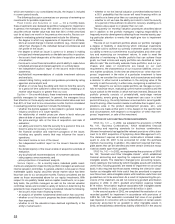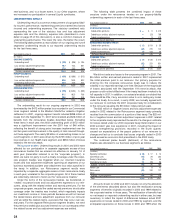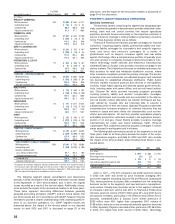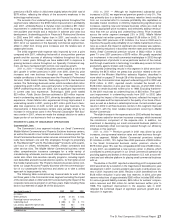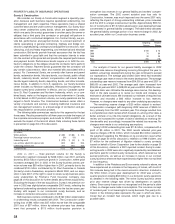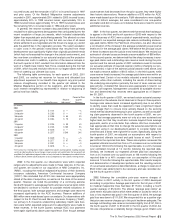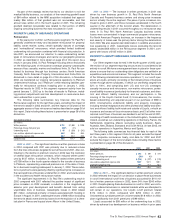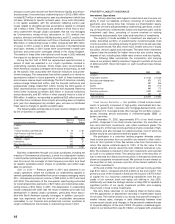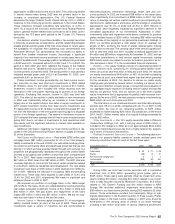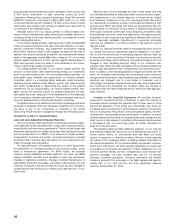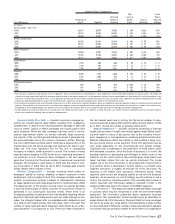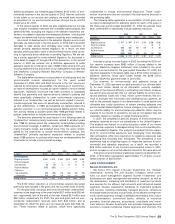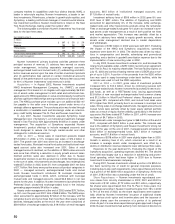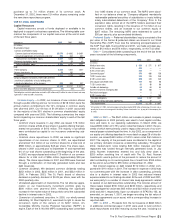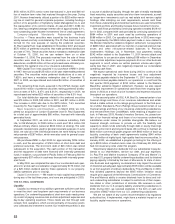Travelers 2002 Annual Report Download - page 44
Download and view the complete annual report
Please find page 44 of the 2002 Travelers annual report below. You can navigate through the pages in the report by either clicking on the pages listed below, or by using the keyword search tool below to find specific information within the annual report.
the promising decrease in average payment amounts. No additional
reserve action was taken.
In the second quarter of 2002, average paid claims for medical mal-
practice lines were again somewhat above expectations, rising to
$130,000 for the quarter. This, coupled with an additional increase in
the average outstanding case reserve to $148,000, prompted man-
agement to reflect these new increased averages in its reserve analy-
sis and record a reserve increase of $97 million.
Throughout 2002, we initiated significant changes to our Health
Care claims organization and resolution process. During the third quar-
ter of 2002, we began to see the results of executing this strategy.
Specifically, case loads per adjuster had begun to decline substantially
and the process for providing oversight on high exposure cases had
been streamlined, enabling a more expeditious approach to our han-
dling of these medical malpractice claims — including the establish-
ment of stronger case reserves. We also added staff with expertise in
high exposure litigation management to assist claim handlers in aggres-
sively pursuing appropriate resolutions on a file-by-file basis. This
allowed us to establish more effective resolution strategies to either
resolve claims prior to going to trial or, for those claims deemed as non-
meritorious, maintain an aggressive defense. We have also become
more selective in determining which cases are taken to trial and more
willing to make use of our right to select defense counsel in those
instances that we decide to litigate.This has caused our ratio of defense
verdicts to plaintiff verdicts to improve over prior years. We began to
more effectively manage our claim disposition strategies to limit the
number of catastrophic verdicts.We believe that executing this strategy
has increased our ability to reduce our ultimate indemnity losses.
As noted above, as part of our focus on claim resolution, we have
increased our emphasis on routinely reviewing our case reserves and
have put in place a process where managers actively review each
adjuster’s entire inventory of pending files to assure, among other
things, that case reserves are adequate to support settlement values.
In addition, as we have moved further into runoff, our mix of paid and
outstanding claims has changed and we expect that our statistical data
will reflect fewer new claims. We expect our claim counts will go down
and the average size of our outstanding and paid claims will go up
since newly reported claims are often settled at minimal loss or loss
expense cost.
In the third quarter of 2002, although our average paid claim
decreased slightly to $126,000, our average outstanding claim reserve
increased to $166,000. We believed that increases in the average out-
standing claim reserve was due to both the claim mix and case
strengthening as described above and was not unexpected in a runoff
environment. Accordingly, we did not record any reserve charge given
the favorable effects we anticipate realizing in future ultimate payments.
In the fourth quarter of 2002, the average paid claim increased to
$153,000 and the average outstanding case reserve increased to
$181,000, which we believe was attributable to the previously described
observations and was reasonable relative to our expectations.
Also during the fourth quarter, we determined that our claim inven-
tory had been reduced considerably and had matured to a level at
which we appropriately began to consider other more relevant data
and statistics suitable for evaluating reserves in a runoff environment.
During 2002, and as described above, we concluded that the
impact of settling claims in a runoff environment was causing
abnormal effects on our average paid claims, average outstanding
claims, and the amount of average case reserves established for new
claims — all of which are traditional statistics used by our actuaries to
develop indicated ranges of expected loss.Taking these changing sta-
tistics into account, we developed varying interpretations of our data
which implied added uncertainty to our evaluation of these reserves. It
is our belief that this data, when appropriately evaluated in light of the
impact of our migration to a runoff environment, supports our view that
we will realize significant savings on our ultimate claim costs.
In the fourth quarter of 2002, we established specific tools and met-
rics to more explicitly monitor and validate our key assumptions sup-
porting our reserve conclusions since we believe that our traditional
42
statistics and reserving methods needed to be supplemented in order
to provide a more meaningful analysis. The tools we developed track
the three primary indicators which are influencing our expectations and
include: a) newly reported claims, b) reserve development on known
claims and c) the “redundancy ratio,” comparing the cost of resolving
claims to the reserve established for that individual claim.
Emergence of newly reported claims — Our Health Care book of
business was put into runoff at the end of 2001 and our outstanding
exposure has rapidly dropped, as expected. Since the majority of cov-
erage we offered was on a claims-made basis, and notification of the
claim must be made within the policy period, the potential for unre-
ported claims has decreased significantly.
We expect that the emergence of newly reported medical malprac-
tice claims, with incurred years of 2002 or prior, would not exceed 40%
of our current outstanding case reserve amount.
Development on known claims — As part of executing our runoff
claims strategy, the inventory of claim-specific case reserves was
reviewed during 2002 in an effort to reserve each claim as appropriately
as possible. This effort is in its advanced stages, and our expectations
for additional reserve strengthening on known claims is considered to
be minimal. We do not expect additional case development on medical
malpractice claims to exceed 3% of existing case reserves.
Case redundancy — While there were claims settlements which
exceeded the claim-specific reserve that had been established, on the
whole, claims are being settled at a level significantly less than the indi-
vidual case reserve previously carried. During 2001, the amount of
excess reserves above settled amounts as a percentage of previously
established reserves (referred to as a redundancy ratio) were in the
range of 25% to 30%. By the end of 2002, the redundancy ratio had
increased to between 35% and 40%.We expect this ratio to stay within
this range to support our best estimate of a reasonable provision for
our loss reserves.
These three indicators are related such that if one deteriorates,
additional improvement on another is necessary for us to conclude that
further reserve strengthening is not necessary.While the recent results
of these indicators support our current view that we have recorded a
reasonable provision for our medical malpractice exposures as of
December 31, 2002, there is a reasonable possibility that we may incur
additional adverse prior year loss development if these indicators sig-
nificantly change from our current expectations. If these indicators
deteriorate, we believe that a reasonable estimate of an additional loss
provision could amount to up to $250 million. However, our analysis as
of this point in time continues to support our belief that we will realize
favorable effects in our ultimate costs and that our current loss
reserves will prove to be a reasonable provision.
2001 vs. 2000 — Price increases averaging 27% in 2001 were the
primary factor in the 13% growth in written premiums over 2000. In
addition, a full year of business volume generated by MMI, acquired in
April 2000, contributed to premium growth in 2001. We significantly
curtailed the amount of new Health Care business in 2001, however,
due to an unfavorable pricing environment and unacceptable loss
experience in most of the lines of business and geographic locations
where we offered our products.
The nearly $1 billion underwriting loss in 2001 was driven by provi-
sions to strengthen loss reserves for prior accident years, particularly
the years 1997 through 1999.The prior-year reserve increases, which
totaled $735 million for the year, culminated in a $540 million provision
in December that coincided with our announcement that we would exit
the medical liability market. The 2001 reserve increases followed
increases recorded in 2000 that primarily related to our long-term care
and major accounts lines of business. The reserve increases in 2000
were prompted by an increase in the severity of losses driven by the
rapidly escalating amounts that were awarded by juries in professional
liability lawsuits.


